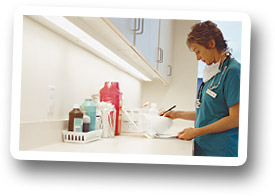IPM 101 Checklist
 Help Your Facility Win the Fight Against Pests
Help Your Facility Win the Fight Against Pests
No one likes to see a cockroach scurrying across the floor or a fly buzzing by the window, and in sensitive health care environments, effective pest control is imperative — the health and safety of patients and staff depend on it. Fortunately, as part of an Integrated Pest Management (IPM) program, you can help reduce pest activity at your facility just by altering your everyday habits. Read on to find out how you can help your facility:
- Use fewer pesticides
- Become more sanitary
- Save the environment by "going green"
- Reduce the chances of a pest infestation
- Protect the health and safety of patients and staff
What is IPM?
Many people think effective pest control relies on pesticide use, but this just isn’t the case. In fact, many health care facilities employ Integrated Pest Management, or IPM, an environmentally friendly approach that focuses on the cause of pest problems, rather than just the symptoms that result. IPM programs strive to eliminate the elements necessary for pests’ survival - food, water, shelter and optimal temperatures - through preventive methods such as better sanitation and facility maintenance measures. The outcome is a long-term solution to pest prevention, rather than a short-term "band-aid."
What should I look for when it comes to pests?
You should always be on the lookout for signs of pests such as droppings, wall markings indicating rodent activity, chewed baits, skins, damaged packaging or actual pests.
Where should I look out for pests?
It’s important to be aware of the common hospital “hot spots” where pests typically are found:
Hot Spot #1: Kitchens & Cafeterias
Pests are not picky eaters, which means cockroaches, ants and even rats can find something to snack on in cafeterias and kitchens, even if it is the dust gathered in cabinet corners. In addition to fresh food, grease runoff and food debris make foodservice areas an open lunchroom for pests.
Hot Spot #2: Break Rooms & Locker Areas
Employee break rooms are notorious for attracting pests when dishes are left sitting in the sink and counters remain unclean. If pests such as fruit flies find open snacks in lockers, they can continue to live relatively undetected in their dark hiding spot.
Hot Spot #3: Laundry Facilities
Warmth, moisture and food residue in laundry areas can also be a concern. These water sources entice rodents and cockroaches, and they often hide behind dryers and in linen storage areas.
Hot Spot #4: Waste Areas
Waste areas attract pests such as wasps and rodents because they offer numerous food sources and hiding spots. Since doors to waste areas open and close throughout the day, pests can easily gain access to the facility.
Other "hot spots" include janitor closets, intensive care units, storage and receiving areas, food transportation equipment, and kidney dialysis rooms.
How can I make a difference?
Here are 10 tips you can incorporate into your every day routine. These small tasks can make a big difference when it comes to keeping pests out of your facility:
- Report pest sightings immediately to either Environmental Services or your pest management professional depending on your hospital’s communication protocols.
- Do not use or store any unauthorized pesticide products.
- Wipe down counters and other surface areas in your workspace.
- Keep food and drink items tightly sealed.
- Do not leave dirty dishes sitting on your desk.
- Clean out lockers regularly.
- Keep clutter to a minimum to eliminate potential hiding and nesting spots for pests.
- Put away food in break rooms.
- Clean up any spills immediately, even if it is just water.
- Report any spills you can’t handle on your own to facility maintenance immediately.


